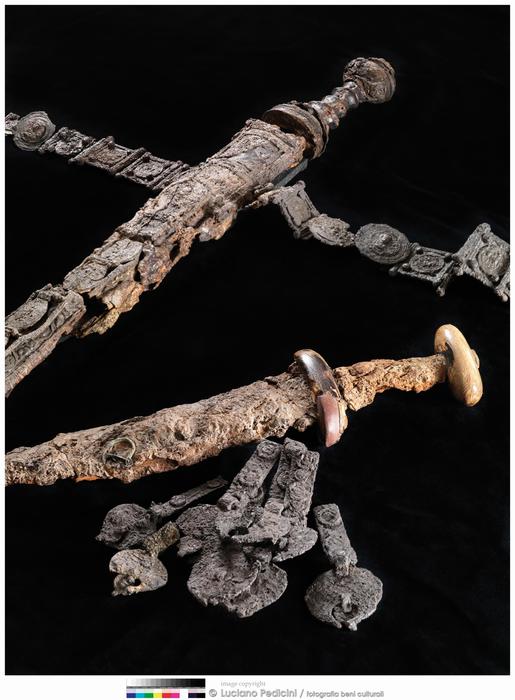

Mount Vesuvius victims died just moments away from rescue
source link: https://arstechnica.com/science/2021/05/mount-vesuvius-victims-died-just-moments-away-from-rescue/
Go to the source link to view the article. You can view the picture content, updated content and better typesetting reading experience. If the link is broken, please click the button below to view the snapshot at that time.

That others may live —
Mount Vesuvius victims died just moments away from rescue
A skeleton unearthed at the site may belong to a high-ranking naval officer.
Kiona N. Smith - 5/14/2021, 4:51 PM

When Mount Vesuvius destroyed the Roman city of Pompeii in 79 CE, the eruption also killed hundreds of people huddled on the shores of nearby Herculaneum. A recent study of the remains of one victim, who died on the beach not far from a small naval vessel, suggests that he might have been a senior naval officer. If so, archaeological director Francesco Sirano and his colleagues suggest, the man may have been a rescue mission leader who arrived just in time to die with the people he was trying to save.
An untimely rescue
Pliny the Elder was a Roman naturalist and author who also found time to command the imperial fleet in the port city of Misenum, across the Bay of Naples from Pompeii and Herculaneum. During the height of Mount Vesuvius' eruption, Pliny the Elder sent boats to rescue survivors from the beach at Herculaneum, which lies northwest of Pompeii and almost due west of the volcano. At least 300 people had fled for the shore, only to find themselves trapped between the volcano’s wrath and the sea. Some sought shelter in nearby boat sheds while others gathered on the beach to wait for help.
They never made it off the beach. A towering plume of material that had blasted skyward from the volcano finally collapsed under its own weight and sent a deadly wave of hot gas and debris, called a pyroclastic flow, flooding down the mountain’s slopes at nearly 100 kilometers per hour (62 miles per hour). Like the pyroclastic flows that struck Pompeii, this one brought instant, searing death.
AdvertisementArchaeologists unearthed the remains of the Herculaneum victims in the 1980s. Now it appears that the 300 victims massed on the shore may have been tantalizingly close to being saved. If Sirano and his colleagues are correct about one victim—now known to the world only as Skeleton Number 26—then the deadly pyroclastic flow struck Herculaneum just as its desperately awaited rescue arrived.
A Roman naval officer?
Just like at nearby Pompeii, layers of volcanic ash quickly buried the victims at Herculaneum. The same eruption that killed them also helped preserve detailed evidence about their lives and the moment of their deaths. For nearly 2,000 years, Skeleton Number 26 lay facedown, with one arm stretched out as if to break his fall. He was probably knocked down by the blast that killed him and everyone else on the beach. Parts of Skeleton Number 26’s armor, along with weapons and a leather knapsack, survived nearly 2,000 years of burial.
Sirano and his colleagues recently took a second look at the skeleton and his belongings, and based on his high-end weapons and gear, the archaeologists suggest that he was probably a high-ranking officer in Pliny the Elder’s imperial fleet from Misenum.
The man, who was between 40 and 45 years old when he died, wore a leather belt decorated with plates of gold and silver. He carried a finely crafted sword with an ornate ivory hilt and a correspondingly elegant dagger. And mingled with his bones, archaeologists found 12 silver and two gold Roman denarii, which would have added up to three or four times the monthly pay of an average enlisted soldier in Rome’s Legions. All together, those accouterments mark him as a military officer with rank and status—and the wealth to show it off.
AdvertisementIn a leather knapsack, the man carried a set of carpenter’s tools. That detail seems to clash with the sword, dagger, and armor, unless the dead man was a faber navalis, or master carpenter. If so, he would have been something like engineering officers aboard modern naval vessels, both a naval leader and a highly advanced technical specialist.
And if that’s the case, then it’s probably not a coincidence that he died not far from a Roman naval vessel beached nearby. “He may be an officer of the fleet that took part in the rescue mission launched by Pliny the Elder to help the people in the towns and villas nestled on this part of the Bay of Naples,” Sirano told Italian news agency Ansa.
Although the artifacts and their context lend support to that idea, there’s not enough evidence to say for certain that Skeleton Number 26 died in the line of duty. It’s a reasonable conclusion, though—much less of a stretch than last year’s sensational claim, by a different team of researchers, that a skull unearthed near Stabiae belonged to the Pliny the Elder.
The fleet commander set sail himself during the eruption to rescue a friend’s wife near the town of Stabiae, and he died on the beach not far from the friend’s villa. Based on his nephew’s secondhand description of events, written years later, the great naturalist and admiral probably died of either a heart attack or respiratory damage from inhaling too much volcanic gas and dust. His remains weren’t recovered, and identifying them definitively today would be nearly impossible.
Pliny the Elder, and at least some of the men he sent into harm’s way as their commander, died doing the same thing: trying to save lives. And 2,000 years later, it’s hard not to respect that.
Recommend
About Joyk
Aggregate valuable and interesting links.
Joyk means Joy of geeK